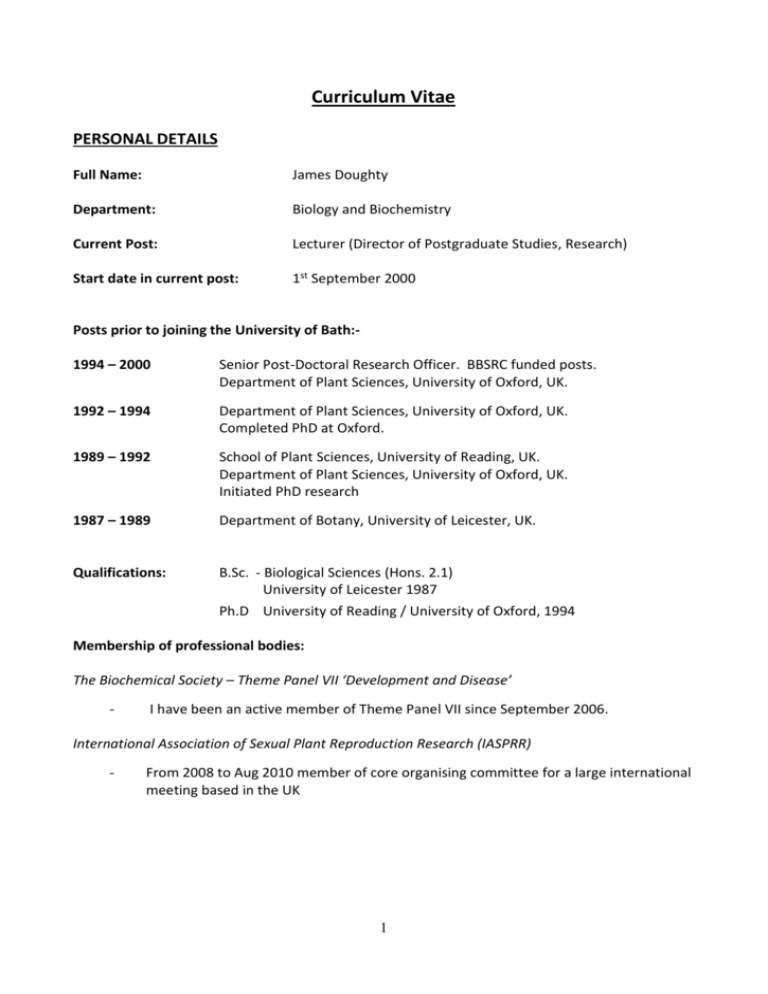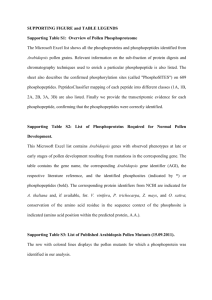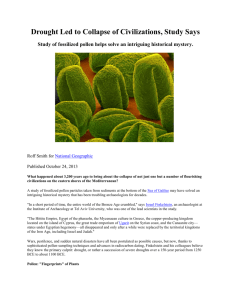Dr James Doughty
advertisement

Curriculum Vitae PERSONAL DETAILS Full Name: James Doughty Department: Biology and Biochemistry Current Post: Lecturer (Director of Postgraduate Studies, Research) Start date in current post: 1st September 2000 Posts prior to joining the University of Bath:1994 – 2000 Senior Post-Doctoral Research Officer. BBSRC funded posts. Department of Plant Sciences, University of Oxford, UK. 1992 – 1994 Department of Plant Sciences, University of Oxford, UK. Completed PhD at Oxford. 1989 – 1992 School of Plant Sciences, University of Reading, UK. Department of Plant Sciences, University of Oxford, UK. Initiated PhD research 1987 – 1989 Department of Botany, University of Leicester, UK. Qualifications: B.Sc. - Biological Sciences (Hons. 2.1) University of Leicester 1987 Ph.D University of Reading / University of Oxford, 1994 Membership of professional bodies: The Biochemical Society – Theme Panel VII ‘Development and Disease’ - I have been an active member of Theme Panel VII since September 2006. International Association of Sexual Plant Reproduction Research (IASPRR) - From 2008 to Aug 2010 member of core organising committee for a large international meeting based in the UK 1 Internal posts of responsibility Director of Postgraduate Studies (Research) – August 2009-present Responsible for all PhD students in the department of Biology and Biochemistry Overseas PG Recruitment Group I have volunteered to represent the University abroad to raise our profile for PG/UG recruitment purposes. In my role of DoS I am keen to be involved in shaping strategy for overseas recruitment and have been moving this forward through the Graduate School Committee. Postgraduate University Scholarship Award Panel Jan 2009 – 10 The Faculty of Science allocated £150,000 of PG fees scholarships last year to enhance PG recruitment. Departments had to put candidates/cases forward which were reviewed and ranked by this panel. Committees external to the University Biochemical Society Theme Panel VI ‘Biological Systems’ Sept 2006 - present I represent the plant science research field on the panel. The panel develops ideas for conferences, considers conference proposals and highlights hot topics to the Meetings Board for inclusion in the conference programme. The Theme Panels also develop interdisciplinary activities and collaborate with appropriate sister societies. We also consider nominations for prestigious Biochemical Society medals, prizes and awards. In addition I am involved in ranking of applications for Scholarships awarded by the society. Committee members are expected to organise conferences. I have lead the organisation of two international focus conferences: 2009 - ‘Cell-Cell Communication in Plant Reproductive Biology’ – University of Bath 2013 - ‘Regulation of fertilisation and early seed development’ – University of Bath International Association of Sexual Plant Reproduction Research (IASPRR) I served as a key member of the organising committee for a major international conference held at the University of Bristol in Aug 2010. This enhanced our links with Bristol and international research groups. My roles included:- engagement with sponsors, publicity and helping organise a BBSRC public outreach event during the meeting. 2 RESEARCH Interests My research interests are currently focussed on i) molecular recognition events and signalling between male and female reproductive cell types in plant species belonging to the Brassicaceae (including oil seed rape, Brassica oleracea and the genetic model Arabidopsis thaliana) and ii) mechanisms that regulate appropriate development of reproductive structures, seeds and gametes. Recognition events between cells are key to appropriate regulation of a multitude of steps in plant sexual reproduction. At the start of the reproductive process recognition between pollen and stigma can lead to either compatibility, where pollen is accepted and seed potentially set, or conversely incompatibility where a breeding barrier is imposed. I am interested in the molecular basis of these barriers both within species and between species. Importantly I was the first to identify a diverse family of pollen-borne small secreted cysteine-rich proteins which have turned out to be important signalling molecules in plant reproduction. Through gene knockout analyses in Arabidopsis I have been dissecting their roles in early pollination. In later stages of plant reproduction the egg cell must fuse with sperm (delivered by the pollen tube). Understanding this highly regulated fusion event is also a focus of my research and I am currently tackling this through the analysis of the Arabidopsis sperm proteome with the aim of identifying cell surface proteins involved in the sperm-egg interaction. In collaboration with Prof Rod Scott (Bath) we have also been investigating mechanisms that prevent multiple sperm cells from fusing with the egg (blocks to polyspermy) – initial findings resulted in a publication (2008) and this work will continue when resources permit. Other collaborative work with the Scott lab includes a study on a gene (ttg2) that appears to be able to regulate seed to development such that seed abortion is ‘rescued’ in normally inviable crosses. A new collaborative project has also been established between the Doughty and Scott labs with the appointment of a second new PhD student (URS Excellent Student). The project involves the identification and characterisation of highly active beta glucanase enzymes involved in male reproductive development. In addition a new area of research is directed at understanding the role of lipid kinases in plant male reproductive development. The research has proved very fruitful resulting in a high profile publication and opportunities for wider external collaborations and grant applications. Interestingly this work may also lead into transgenic approaches to improve a plant’s ability to tolerate osmotic stress (drought). Major research achievements: i) Roles of small cysteine-rich proteins in reproductive biology - I would consider one of my most significant research achievements to be the identification of a diverse group of small cysteine-rich proteins in pollen (PCPs / CRPs) which have crucial roles in cell-cell signalling during plant reproduction. In particular I showed that certain members of this family were capable of binding stigmatic proteins known to be involved in pollen recognition and rejection (self-incompatibility). I was the first to identify the importance of these proteins in this context and my initial work paved the way for further exciting developments by labs around the world. These protein ligands are now known to be involved at multiple stages of plant reproduction from the pollen-stigma interaction to acting as guidance cues for targeting of pollen tubes to egg cells. Although in recent 3 years my research in this area has been under resourced I have maintained a research programme that will result this coming year in a publication. This work demonstrates that PCPs play a role in regulating hydration of pollen in compatible pollinations and I anticipate the work to be worthy of publication in a good journal. ii) Establishing methodologies for the isolation and characterisation of Arabidopsis sperm cells – Over the last 5 years or so work in the lab has also focussed on developing a solid methodological foundation for work on Arabidopsis sperm cells. The isolation of pure Arabidopsis sperm has proved to be a major technological hurdle to research in this field, particularly in the area of understanding the sperm-egg interaction. This work formed a major part of the research carried out by a PhD student in the lab and we were successful, for the first time, in developing an efficient Arabidopsis sperm isolation protocol that involved enzymatic digestion of the pollen wall, osmotic shock and Fluorescence Activated Cell Sorting (FACS) of released sperm. Preliminary proteomic and molecular data has been obtained from these sperm cells proving their purity. Importantly this work will form the foundation of future research proposals. The impact of this technical advance will undoubtedly feed into research both in my lab and others in the coming years. iii) FAB1 lipid kinases play crucial roles in pollen development - Phosphatidylinositol 3,5 bisphosphate (PtdIns(3,5)P2) is a phospholipid that has a role in controlling membrane trafficking events in yeast and animal cells. The function of this lipid in plants was until recently unknown although its synthesis has been shown to be upregulated upon osmotic stress in plant cells. In a recent collaboration with Paul Whitley (Bath) we were able to identify genes in Arabidopsis that encode proteins responsible for the synthesis of PtdIns(3,5)P 2 and look at the consequences of knocking out these genes. Our data showed that PtdIns(3,5)P2 is crucial for modulating the dynamics of vacuolar rearrangement during pollen development, a process that permits pollen grains to cope with a dramatic process of dehydration as they mature. Importantly this adds weight to the thesis that this lipid is essential in cellular responses to reduced water availability and could therefore be a good target in relation to engineering plants with increased resistance to drought. Our work was published in a high profile plant journal in 2009. Key Research Audiences: My particular research field is truly international with major groups working on plant reproductive biology in the UK, USA, and other European nations, Japan, China and Australia. Interest in plant signalling biology in not just restricted to the plant science community but is also seen as import to researchers working on other model organisms. The research audience is largely academic however industry has always had a keen interest in understanding the nature of hybridisation barriers between species. Impact of Research: The impact of my research has to some extent been alluded to in previous sections; briefly:i) Work on PCPs / CRPs – my work was the first to identify small cysteine-rich proteins as key players in signalling events during reproduction. This work has continued not only in my own lab but internationally and this field has been particularly vibrant over the last 5 years with many 4 conferences having a significant number of papers being presented on related proteins with diverse roles in reproduction. My work also led to the discovery of the pollen-borne factor for selfincompatibility in Brassica, a major research goal that had eluded researchers in the field for 15 years – unfortunately a group at Cornell beat me to this. ii) FAB1 lipid kinases and role of PtdIns(3,5)P2 in vacuolar dynamics – this work was published within the last year and interest in the academic community is evident. For the first time this demonstrated a crucial role for PtdIns(3,5)P2 in regulating membrane trafficking and vacuolar dynamics in plants. This has very recently led to the establishment of a new collaboration with the lab of Rui Malho (Lisbon) to investigate the role of other FAB1-related proteins in Arabidopsis. Publications Articles in Journals 1, Qi, B.; Doughty, J.; Hooley, R. (2013). A Golgi and tonoplast localized S-acyl transferase is involved in cell expansion, cell division, vascular patterning and fertility in Arabidopsis. New Phytologis, 200, 444-456 2, Whitley, P., Hinz, S., Doughty, J. (2009). Arabidopsis FAB1 / PIKfyve proteins are essential for development of viable pollen. Plant Physiology, 151, 1812-1822. Scott, RJ; Armstrong, SJ; Doughty, J; Spielman, M (2008). Double fertilization in Arabidopsis thaliana involves a polyspermy block on the egg but not the central cell. Molecular Plant 1 (4):611619. 3, Kemp, BP; Doughty, J (2007). S cysteine-rich (SCR) binding domain analysis of the Brassica selfincompatibility S-locus receptor kinase. New Phytologist 175 (4):619-629 4, Kemp, B.P. and Doughty, J. (2003). Just how complex is the Brassica S-receptor complex? Journal of Experimental Botany, 54, 157-168. 5, Doughty, J., Wong, H.Y. and Dickinson H.G. (2000). Cysteine-rich pollen coat proteins (PCPs) and their interactions with stigmatic S (incompatibility) and S-related proteins in Brassica: putative roles in SI and pollination. Annals of Botany, 85, suppl. A, 161-169. 6, Dickinson, H.G., Elleman, C.J. and Doughty, J. (2000). Pollen coatings – Chimaeric genetics and new functions. Sexual Plant Reproduction, 12, 302-309. 7, Doughty, J., Dixon, S., Hiscock, S.J., Willis, A.C., Parkin, I.A.P and Dickinson, H.G. (1998). PCP-A1, a defensin-like pollen coat protein that binds the S-locus glycoprotein, is the product of gametophytic gene expression. The Plant Cell, 10, 1333-1347 8, Stephenson, A.G., Doughty, J., Dixon, S., Elleman, C. Hiscock, S. and Dickinson, H.G. (1997). The male determinant of self-incompatibility in Brassica oleracea is located in the pollen coating. The Plant Journal, 12, 1351-1359. 9, Ruiter, R.K., Mettenmeyer, T., van Laarhoven, D., van Eldik, G.J., Doughty, J., van Herpen, M.M.A., Schrauwen, J.A.M., Dickinson, H.G. and Wullems, G.J. (1997). Proteins of the pollen coat of Brassica oleracea. Journal of Plant Physiology, 150, 85-92. 10, Stanchev, B.S., Doughty, J., Scutt, C.P., Dickinson, H.G. and Croy, R.R.D. (1996). Cloning of PCP1, a member of a family of pollen coat protein (PCP) genes from Brassica oleracea encoding novel cysteine-rich proteins involved in pollen-stigma interactions. The Plant Journal, 10, 303-313. 5 11, Hiscock, S.J., Doughty, J., Willis, A.C. and Dickinson H.G. (1995). A 7-kDa pollen coating-borne peptide from Brassica napus interacts with S-locus glycoprotein and S-locus related glycoprotein. Planta, 196, 367-374 12, Hiscock, S.J., Doughty, J., and Dickinson, H.G. (1995). Synthesis and phosphorylation of pollen proteins during the pollen-stigma interaction in self-compatible Brassica napus L. and selfincompatible Brassica oleracea L. Sexual Plant Reproduction, 8, 345-353. 13, Doughty, J., Heddereson, F., McCubbin, A. and Dickinson, H.G. (1993). Interaction between a coating-borne peptide of the Brassica pollen grain and S (incompatibility)-locus linked stigmatic glycoproteins. Proceedings of the National Academy of Sciences USA, 90, 467-471 Forthcoming Publications Eason, R., Hayes, K and Doughty, J. (20114). PCP-B class pollen coat proteins are required for rapid initiation of pollen hydration in Arabidopsis thaliana. Manuscript in preparation for Plant Journal (impact factor 6.95) Tratt, J., Speilman, M., Aljabri, M.,. Doughty, J. and Scott, R.J. (2014). Maternal control of endosperm development and seed size through the flavonoid biosynthesis pathway. Manuscript in preparation for The Plant Cell (impact factor 10.6). Peer Reviewing Activity I am regularly invited to review manuscripts submitted to a range of plant journals and I also review grants for the BBSRC. 6





